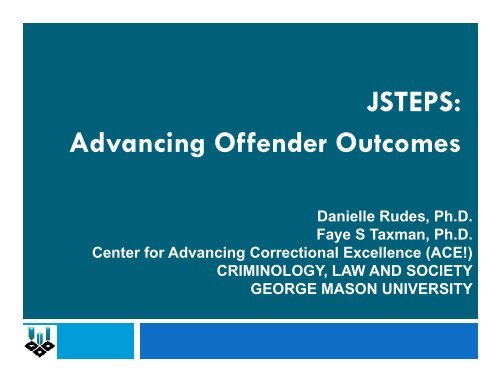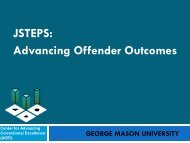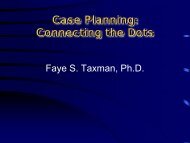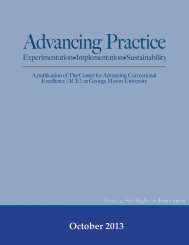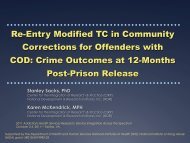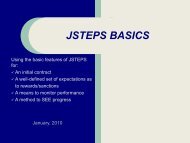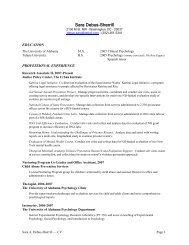Taxman, F. & Rudes, D. "JSTEPS: Advancing Offender Outcomes,"
Taxman, F. & Rudes, D. "JSTEPS: Advancing Offender Outcomes,"
Taxman, F. & Rudes, D. "JSTEPS: Advancing Offender Outcomes,"
- No tags were found...
You also want an ePaper? Increase the reach of your titles
YUMPU automatically turns print PDFs into web optimized ePapers that Google loves.
<strong>JSTEPS</strong>:<br />
<strong>Advancing</strong> <strong>Offender</strong> <strong>Outcomes</strong><br />
Danielle <strong>Rudes</strong>, Ph.D.<br />
Faye S <strong>Taxman</strong>, Ph.D.<br />
Center for <strong>Advancing</strong> Correctional Excellence (ACE!)<br />
CRIMINOLOGY, LAW AND SOCIETY<br />
GEORGE MASON UNIVERSITY
Challenges to Implementing EBPs<br />
Moving EBPs from clinical settings to real world<br />
work environments (“bench to trench”) is<br />
challenging.<br />
g<br />
Are there enough resources to implement?<br />
Is the organizational climate ready for the EBP?<br />
Do managers/supervisors support the EBP?<br />
Can street-level workers understand, accept and<br />
incorporate the EBP into routine practice?<br />
Will the EBP serve needs of clients in this organization?
Research Methods: Quan+Qual<br />
‣Two learning sessions<br />
‣Surveys (attitude measures) to understand different system<br />
actor perspectives<br />
‣Monthly technical Assistance (TA) on-site, via telephone &<br />
email<br />
‣Analysis of offender data to learn about impact on outcomes,<br />
substance abuse, rearrest, etc..
Innovative Qualitative Methods<br />
‣Longitudinal interviews and non-participant<br />
observation to learn about systems and<br />
organizational actors’ experiences<br />
‣Baseline<br />
‣At learning sessions<br />
‣Follow-up<br />
‣Monthly conference calls<br />
‣TA qualitative “process” data collection<br />
‣Subject-generated data (via presentations)
Site Overview<br />
Site One: Drug court & Reentry court<br />
Site Two: Reentry court<br />
Site Three: Drug Court & Gang Court<br />
Site Four: Regular caseload (3x per officer)<br />
Site Five: Halfway House
<strong>JSTEPS</strong> Continuous Feedback Loop<br />
1. Sites agree<br />
to join <strong>JSTEPS</strong><br />
study<br />
2. Initial Site<br />
Visits Occurred<br />
ACE! Training<br />
Seminar<br />
Practitioner<br />
Teams self-<br />
design CM<br />
protocols<br />
Feedback<br />
Reports Follow<br />
Up Phone Calls<br />
& Emails<br />
Initial<br />
Feedback<br />
Reports, On-<br />
Site Coaching<br />
& TA<br />
Practitioner<br />
Teams<br />
considered<br />
feedback,<br />
some revised<br />
(site visits)
8 Main CM Principles<br />
Positive incentives w/ point system<br />
<br />
Clear guidelines about earning points<br />
Emphasize abstinence<br />
<br />
Early incentives<br />
<br />
Pit Point escalation lti<br />
<br />
Integrating point system into existing system<br />
<br />
Bonuses<br />
<br />
Focus on no more than 3 behaviors at a time
CM Principles<br />
Site One Site Two Site Three Site Four Site Five<br />
Positive<br />
incentives w/ High Priority High Priority High Priority High Priority High Priority<br />
point system<br />
Clear<br />
guidelines Low Priority Low Priority Low Priority Low Priority Low Priority<br />
about earning<br />
pts.<br />
Emphasizes<br />
abstinence Low Priority Low Priority No Priority Low Priority High Priority<br />
Early<br />
incentives Low Priority No Priority No Priority Low Priority High Priority<br />
Point escalation<br />
Integrating gpt.<br />
system into<br />
existing system<br />
No Priority Low Priority Low Priority Low Priority High Priority<br />
Low Priority High Priority Low Priority Low Priority High Priority<br />
Bonuses<br />
Low Priority High Priority No Priority Low Priority High Priority<br />
No more than 3
Major Themes from Sites<br />
• Varying emphasis on abstinence: 5 of 7 point<br />
systems reward negative UAs<br />
• Early incentives emphasized in 2 sites<br />
• Few sites elected to be transparent about <strong>JSTEPS</strong>,<br />
telling participants up front how points and rewards<br />
are earned<br />
• Large variation in sanctions: for first positive UA,<br />
Large variation in sanctions: for first positive UA,<br />
vary from verbal reprimand to 7 days in custody
Sites’ Definitions of CM<br />
• Reinforcing i positive (desired) d) behavior (all)<br />
• Behavior therapy using a reward and punishment<br />
principle i (1 site)<br />
• Process of using structures, progressive rewards<br />
paired with swift and certain sanctions (2 sites)<br />
• Evidence-based practice (2 sites)<br />
• Focus on target goals (1 site)<br />
• Supplements current program (1 site)
Challenges with CM Implementation<br />
Conceptual<br />
Merging point system<br />
with existing system(s)<br />
Lack of judiciary<br />
support for rewards<br />
Finding appropriate<br />
sanctions<br />
Behavioral contracting<br />
Practical<br />
Learning curve with<br />
software<br />
Increased PO workload<br />
Needing to meet clients<br />
in office instead of field<br />
Ability to deliver<br />
rewards in timely<br />
manner<br />
Lack of reward funding
Probationer Responses to CM<br />
Excited for the opportunity to earn rewards<br />
Ambivalent about the program<br />
Curious about the program<br />
Helps stay focused/motivated<br />
Difficulty understanding di the concept<br />
Like seeing progress in tangible way<br />
Incentives are not large enough
Recognizing g Contextualized Feedback<br />
Competing<br />
Goals<br />
Effectiveness vs. Efficiency<br />
Equity vs. Performance<br />
Intra-Org<br />
Challenges<br />
e.g. Bad press;<br />
legitimacy, etc.<br />
Redefining<br />
the EBP<br />
Perception and Fit
Papers & Next steps…<br />
Acceptability & How can we ensure<br />
Feasibility of CM in feedback loops<br />
Justice Settings<br />
adequately consider<br />
t h”<br />
Roles & Power in<br />
context in “bench-trench”<br />
Problem Solving Courts<br />
partnerships?<br />
<br />
Loose Coupling and<br />
How can we ensure that<br />
EBPs<br />
street-level workers<br />
understand, accept and<br />
<strong>Advancing</strong> qualitative<br />
incorporate the EBP into<br />
methods in EBP<br />
routine practice? Is this<br />
implementation<br />
measureable? In what<br />
ways?


